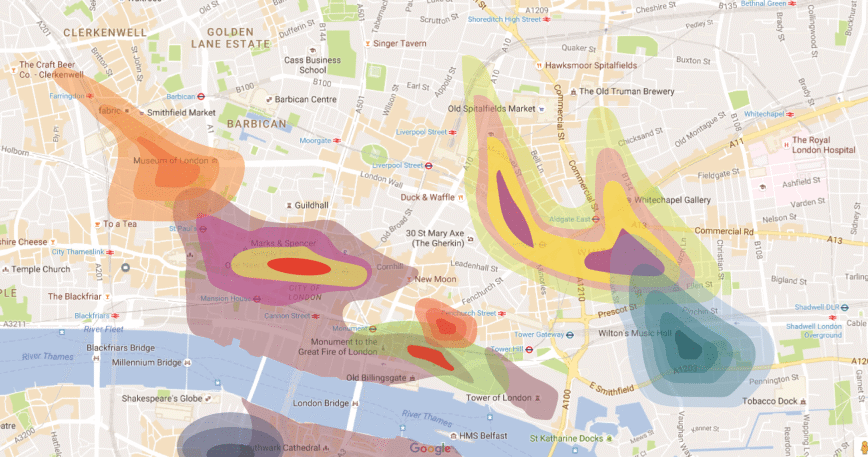On-Demand Webinars
Environmental Forensic Techniques:
Principles & Applications
Part 1: Contaminant Source Tracking and Age-Dating
This webinar series aims to provide the audience with an understanding of what are the main environmental forensic techniques (except modeling techniques) for source evaluation and age-dating and how to apply them for different types of contaminants and contamination scenarios. In the second part, several real case studies will be discussed to illustrate how multiple forensic techniques were used to build strategic approaches for challenging legal cases or in routine site investigation and remediation, providing substantial cost-savings.
Part 1 includes the presentation of the following techniques: historical document and aerial photography review; chemical fingerprinting; signature chemicals; isotopic fingerprinting; mineralogical fingerprinting; atmospheric tracers; and tree-ring fingerprinting. Their application for source evaluation and age-dating of a variety of classic and emerging contaminants will be explained, including crude oil & petroleum products, chlorinated solvents, metals, 1,4-dioxane and PFAS. These techniques may reveal multiple releases being effective when tracking old contamination that may have started decades ago, thereby enabling attendees to reconstruct past contamination events and provide defensible evidence that can stand the scrutiny of the court of law. At the same time, environmental forensics techniques may be integrated in routine work for more effective and expedited site characterization and remediation.
Part 2 includes real case studies along with practical applications of various techniques discussed in Part 1. A review of classes, structure, properties, sources and environmental investigations with forensic relevance for PFAS emerging contaminants will also be included in this part. Examples of the case studies to be discussed are: forensic evaluation at two neighboring chemical storage & repackaging facilities with recorded multiple releases in S. California; evaluating background metal concentration and impacts from a historical foundry near the city of Lyon, France; age-dating petroleum releases at a historical gas station in Northeast U.S.; evaluation of PFAS releases from U.S. landfills; application of chemical fingerprinting in site investigation at petroleum sites in S. California. This webinar series will include formal presentations, as well as interactive discussion with the audience.
This webinar series presents the essential information for a large variety of environmental contamination issues, including those involving legal liability and complex site contamination characterization and remediation. Part 2 includes an overview of state-of-the-knowledge on PFAS emerging contaminants and reported forensic applications The webinar is intended for a large variety of environmental professionals, including, but not limited to, environmental consultants, regulators, industrial site owners and operators (e.g., manufacturers, mining companies, foundry operators, refineries, dry cleaners, landfill operators, professionals involved in military sites investigation & clean-up), insurance agency employees, environmental lawyers, governmental employees, and graduate students.

Why you should attend this webinar
We know there is plenty of freely available information and many free webinars you may attend. What makes this webinar series unique and worth paying for is that it is filtering information from thousands of available sources and using the author more than 15 years of experience in the field to teach you:
- step-by-step how to use various forensic fingerprinting techniques in a variety of real world applications
- what literature articles provide key information related to the presented techniques and their applications in source evaluation, age-dating and/or source allocation
- what you need to know to tackle tough emerging contaminants such as PFAS and 1,4-dioxane for proper site characterization and source identification, as well as fate & transport evaluation
Part One will answer:
Contaminant Source Tracking and Age-Dating
- What are the main environmental forensic techniques for source evaluation and age-dating of contaminant releases?
- How to select appropriate techniques based on contaminant type and case study specifics?
- How to use these techniques for petroleum contaminants, chlorinated solvents and metals?
- What techniques are applicable to emerging contaminants such as PFAS (per-and polyfluoroalkyl substances) and 1,4-dioxane?
- What are the limitations of each technique?
- What are practical considerations related to sampling?
- What analytical methods and laboratories may be used?
- Where to find additional information?
Part Two will answer:
Applications for Classic and Emerging Contaminants in Litigation Support and Efficient Site Remediation
- How were these techniques applied in real case studies involving petroleum, chlorinated solvents and metals?
- How and which techniques have been applied to emerging contaminants such as PFAS (per-and polyfluoroalkyl substances) and 1,4-dioxane?
- How to build strategic approaches in litigation support, site investigation or remediation applications?

Highlights:
General:
- Environmental forensics techniques principles and step-by-step using guide
- Applications examples for a variety of classic and emerging contaminants (including crude oil & petroleum products, chlorinated solvents, metals, 1,4-dioxane, and PFAS)
- Review of the state-of-knowledge related to emerging contaminants (including PFAS and 1,4-dioxane) and applicable forensic techniques
- Limitations
- Practical considerations related to sampling and analytical techniques
- Building defensible independent lines of evidence for expert witness/litigation support
- Applications of forensics techniques for improved site characterization & remediation
- Illustrative case studies & strategy building tips
Part One:
- What are environmental forensic techniques?
- Principles & applications of main environmental forensic techniques:
- Historical document and aerial photography review
- Chemical fingerprinting
- Signature chemicals
- Isotopic fingerprinting - CSIA use in contaminant source and fate & transport evaluation;
- Mineralogical fingerprinting
- Atmospheric tracers
- Tree-ring fingerprinting (dendroecology)
- Specific application techniques for crude oil & petroleum contaminants, chlorinated solvents, metals. 1,4-dioxane and PFAS
- Things to consider when planning a forensic investigation (e.g., analytical methods and laboratories, sampling plan)
Part Two:
- Case studies related to the use of environmental forensic lines of evidence for:
- Litigation support
- Site investigation
- Contaminant background investigations
- Site remediation
- Review of the state-of-knowledge related to PFAS emerging contaminants and case studies of forensic relevance
- Review of emerging applications for 1,4-dioxane environmental forensic evaluations
- Strategic approaches for different types of common challenges
Benefits:
- Learn the main environmental forensic techniques for contaminant source tracking and age-dating
- Understand how to apply these techniques in legal cases, as well as to improve site characterization and remedial outcome
- Review the principles related to applications for classic (e.g., crude oil & petroleum products, chlorinated solvents, metals), as well as emerging contaminants (e.g., PFAS; 1,4-dioxane)
- Be up-to-date with the knowledge on emerging PFAS contaminants, including structure, properties, sources, applicable forensic techniques and relevant case studies
- Understand interfering factors and plan defensible investigations
- Build effective strategic approaches in complex contamination cases
Instructors Bio
Dr. Ioana G. Petrisor
Biochemist
Editor-in-Chief of Environmental Forensics Journal
Author of "Environmental Forensics Fundamentals - A Practical Guide"
 Dr. Ioana G. Petrisor, Biochemist, Editor-in-Chief of Environmental Forensics Journal and author of the book "Environmental Forensics Fundamentals - A Practical Guide", has 26 years of experience in the environmental field as a consultant, scientific researcher and instructor. She used state-of-art environmental forensics techniques to track the source and age of released contaminants, helping national and international clients recover costs in complex cases involving multiple contaminants and releases in time and space. Dr. Petrisor is a regularly invited keynote speaker at national and international meetings, has taught both on-line and in-class workshops and courses, and has conducted innovative research for U.S. DOE, U.S. DOD, and the European Community on environmental characterization, risk assessment, and development of innovative remedial technologies for soil, sediments, and water. Dr. Ioana G. Petrisor, Biochemist, Editor-in-Chief of Environmental Forensics Journal and author of the book "Environmental Forensics Fundamentals - A Practical Guide", has 26 years of experience in the environmental field as a consultant, scientific researcher and instructor. She used state-of-art environmental forensics techniques to track the source and age of released contaminants, helping national and international clients recover costs in complex cases involving multiple contaminants and releases in time and space. Dr. Petrisor is a regularly invited keynote speaker at national and international meetings, has taught both on-line and in-class workshops and courses, and has conducted innovative research for U.S. DOE, U.S. DOD, and the European Community on environmental characterization, risk assessment, and development of innovative remedial technologies for soil, sediments, and water.
Her extensive publication experience includes an invention patent, a text book, 6 book chapters, 12 editorials, and over 70 articles. Dr. Petrisor has a PhD in Biology (Environmental Biotechnology) from Romanian Academy of Sciences and a Bachelor in Chemistry (major Biochemistry) from Bucharest University in Romania. She has completed an UNESCO training program in Plant Molecular Genetics at the University of Queensland, Brisbane, Australia and is the recipient of "The Greatest Award of Successful Careers for Outstanding Scientific Results and Professional Activity" issued by Cosmopolitan Magazine, Romania in 2000.
| Fee: |
299.00 USD Per Webinar
|
| |
Only $170.00 USD Per Computer Site*
* Member Pricing when you register for Parts 1 and 2 of this Series
(discount is applied during checkout when both parts are in your cart)
SAVE $50 USD just for being a Member
(discount will be applied during checkout)
|
| Materials and Downloads: |
Session Slides (PDF)
Record of Attendance Form (PDF)
|
Number of
Participants: |
AS OF JUNE 1, 2020, WEBINARS ARE PRICED FOR INDIVIDUALS WORKING ALONE. Pricing is discounted for individual registrations for people working alone.
|
Continuing
Education
Certificates: |
$14.95 each. Official CEU certificates are available as an option. After successful completion of this webinar, a link will be provided to order a certificate.
|
| Access: |
On-demand, anytime 24/7. |
| Discounts: |
Buy 3 on-demand webinars, and get 3 on-demand webinars for free!
|
| Duration: |
90 minutes |
| PDH Earned: |
1.5 hours |
| |
|
| Instructor(s): |
Ioana G. Petrisor, PhD |
|
Become A Member
It's Free, It's Easy and as a
Member you'll enjoy...
- Exclusive Videos
- Special Pricing
- And Much More
|
|
Join
|
Learn More
|
Association of Environmental
& Engineering Geologists
|